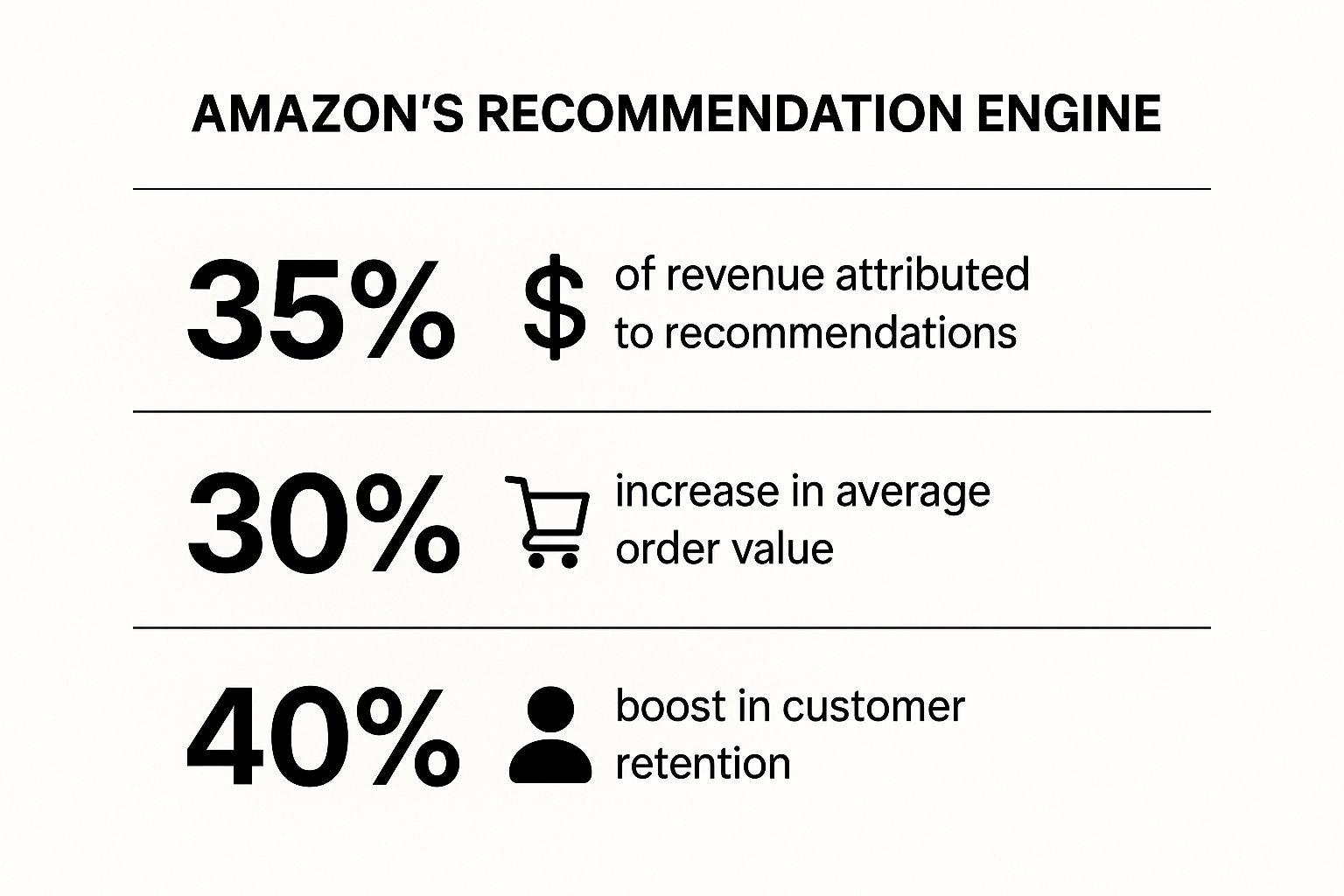In today's competitive market, a one-size-fits-all approach to sales and marketing is a recipe for failure. The key to unlocking sustainable growth lies in understanding that your customer base is not a monolith but a collection of distinct groups with unique needs, behaviors, and motivations. This is the power of strategic customer segmentation. By dividing your audience into smaller, more manageable segments, you can tailor your messaging, product development, and overall customer experience to resonate deeply with each group. This targeted approach not only boosts conversion rates and ROI but also fosters stronger, more profitable customer relationships.
However, knowing you should segment is different from knowing how to do it effectively. The real challenge is in identifying the right variables and creating meaningful groups that drive direct action. This article moves beyond theory to provide eight real-world customer segmentation examples from industry-leading brands like Amazon, Nike, and Tesla. We will dissect the 'how' and 'why' behind their success, breaking down their strategies into actionable takeaways you can apply to your own business, whether you're a solo freelancer or part of an enterprise sales team. Get ready to learn from the best and transform your marketing from broad strokes to surgical precision.
1. Amazon's Behavioral Targeting and Personalization
Amazon stands as a masterclass in behavioral customer segmentation, moving beyond simple demographics to understand what customers do. The e-commerce giant meticulously tracks user actions like browsing history, past purchases, items viewed but not bought, and even how long a cursor hovers over a product image. This creates dynamic, real-time customer profiles.
This approach allows Amazon to build one of the most sophisticated recommendation engines in the world. Instead of seeing a generic homepage, each user experiences a unique, personalized storefront. This is one of the most powerful customer segmentation examples because it directly translates actions into a tailored shopping journey.
Strategic Analysis
Amazon's strategy is rooted in the principle of predictive personalization. By analyzing billions of data points, its algorithms can anticipate customer needs and interests with remarkable accuracy.
Key Insight: The core of Amazon's success isn't just recommending similar products. It's about building a "taste graph" for each user, connecting seemingly unrelated items based on the collective behavior of millions of other shoppers.
This deep level of segmentation powers everything from the famous "Customers who bought this item also bought" feature to targeted email campaigns reminding you about an item left in your cart.
The following infographic highlights the staggering financial impact of Amazon's finely-tuned recommendation engine.

These statistics reveal that personalization is not just a user-experience enhancement; it's a primary driver of revenue, customer loyalty, and increased transaction value.
Actionable Takeaways
You don't need Amazon's resources to apply these principles. Businesses can implement behavioral segmentation by:
- Starting with Cart Abandonment: Set up automated emails to remind customers about items left in their cart. This is a simple, high-impact first step.
- Tracking On-Site Searches: Analyze what users are searching for on your website. This data is a direct line into customer intent and can inform product development and marketing campaigns.
- Using Basic Recommendation Tools: Many e-commerce platforms have built-in plugins for "recently viewed items" or "related products" to begin personalizing the shopping experience.
2. Spotify's Music Preference and Listening Behavior Segmentation
Spotify has transformed music streaming by pioneering a sophisticated form of psychographic and behavioral segmentation. The platform goes far beyond genre preferences, analyzing a rich tapestry of user data including listening times, device usage, playlist creation habits, and even song skips. This creates a detailed, evolving profile for each of its millions of users.
This granular approach allows Spotify to deliver hyper-personalized music experiences. Instead of a one-size-fits-all library, users receive curated playlists like the celebrated "Discover Weekly" and various "Daily Mixes." This is one of the most compelling customer segmentation examples because it turns passive listening into an interactive journey of discovery, driven entirely by individual behavior.

Strategic Analysis
Spotify's strategy is centered on creating an "audio identity" for every user. It uses a combination of collaborative filtering (what similar users listen to) and natural language processing (analyzing text about music) to understand the context and mood behind listening choices.
Key Insight: Spotify's genius lies in using data not just for recommendations, but for creating moments. By understanding that a user listens to "Focus" playlists during workdays and "Party" mixes on Friday nights, it can serve the right content at the exact right time, making the service feel indispensable.
This deep segmentation fuels iconic features like the annual "Spotify Wrapped," which transforms personal listening data into shareable social content. This not only delights users but also serves as powerful organic marketing, showcasing the platform's personalization prowess. The segmentation also informs which new artists are promoted to specific user groups, creating a powerful music discovery engine.
Actionable Takeaways
Businesses can mirror Spotify's success in engagement by focusing on implicit user feedback:
- Collect Behavioral Data: Track how users interact with your content or products. Note what they engage with most, what they skip, and when they are most active.
- Create Contextual Experiences: Use time-of-day or day-of-week data to tailor your messaging. A B2B service might send productivity tips on a Monday morning, for example. Explore more about how timing impacts B2B engagement with these lead generation strategies and tips on salesloop.io.
- Balance Personalization with Discovery: While catering to known preferences is key, also introduce users to new but related offerings. This prevents their experience from becoming stale and broadens their engagement with your brand.
3. Nike's Lifestyle and Activity-Based Segmentation
Nike excels at psychographic and lifestyle segmentation, understanding that a customer's identity is often tied to their athletic pursuits and aspirations. The brand segments its audience based on sports activities (running, basketball, soccer), fitness levels (professional, amateur, enthusiast), and lifestyle choices, creating distinct "personas" for each group.
This strategy allows Nike to develop highly targeted product lines and marketing campaigns that resonate on a personal level. Instead of just selling shoes, Nike sells an identity. The Nike Run Club app targets dedicated runners, the Jordan brand caters to basketball culture, and its lifestyle collections appeal to fashion-conscious consumers. This is one of the most effective customer segmentation examples because it builds communities around shared passions.

Strategic Analysis
Nike's strategy is built on creating authentic brand ecosystems for each segment. It doesn't just market to runners; it provides tools, community, and inspiration for runners through its apps and events. This turns a transactional relationship into an emotional and participatory one.
Key Insight: Nike's success comes from selling the feeling of athletic achievement, not just the gear. By segmenting based on activity and aspiration, it aligns its products with the customer's personal goals and self-image, fostering deep brand loyalty.
This segmentation drives everything from product design to athlete endorsements. The "Just Do It" slogan acts as a unifying brand promise, but its execution is carefully tailored to speak the specific language of each activity-based community, whether it's a marathon runner or a streetwear enthusiast.
Actionable Takeaways
Businesses can adopt Nike's approach by focusing on the "why" behind their customers' purchases.
- Develop Customer Personas: Go beyond demographics. Create detailed profiles based on your customers' hobbies, goals, and values. What motivates them?
- Build a Community: Create a space for your segments to connect. This could be a Facebook group, a dedicated forum, or a specialized app that provides value beyond your product.
- Use Segment-Specific Messaging: Craft marketing campaigns that speak directly to the unique needs and language of each persona. A message for an expert will differ from one for a beginner.
4. Tesla's Psychographic and Value-Based Segmentation
Tesla's approach to the market transcends traditional automotive demographics, focusing instead on the psychographics and values of its customers. The company segments its audience based on their mindset, including their passion for innovation, environmental consciousness, and desire for high-performance technology. This allows Tesla to target early adopters, eco-advocates, and luxury buyers who prioritize cutting-edge features over conventional status symbols.
By appealing to a customer's identity and beliefs, Tesla builds an incredibly loyal brand community. This is one of the most compelling customer segmentation examples because it shows how a brand can become a movement by aligning its products with a core value system, from the Model 3 for the environmentally-aware mass market to the Cybertruck for those who champion radical innovation.
Strategic Analysis
Tesla’s strategy is built on a deep understanding of its target audience's motivations, not just their needs. The brand doesn't just sell cars; it sells a vision of the future, sustainability, and technological disruption. This segmentation method allows for highly resonant marketing that feels more like a shared belief system than a sales pitch.
Key Insight: Tesla's success lies in creating distinct products that map directly to specific psychographic profiles. Each model tells a different story and appeals to a unique facet of the "innovator" or "environmentalist" persona, creating a powerful emotional connection.
This value-based segmentation drives everything from product design to marketing narratives. The focus on sustainability attracts one segment, while the raw performance and "Ludicrous Mode" of the Model S attracts another, all under the same brand umbrella. Developing these detailed profiles is a critical step; you can learn more about creating a buyer persona to apply a similar strategy.
Actionable Takeaways
Businesses of any size can leverage psychographic segmentation by focusing on customer values and beliefs.
- Align Products with Values: Develop products or frame services to resonate with the core values of your target audience. If your customers value sustainability, highlight your eco-friendly practices.
- Build a Community: Use social media and events to create a space where customers with shared beliefs can connect with your brand and each other, fostering loyalty.
- Leverage Customer Stories: Feature testimonials and case studies that highlight how your product aligns with customers' lifestyles and values, providing authentic social proof.
5. Starbucks' Occasion-Based and Frequency Segmentation
Starbucks excels at segmenting its customer base not just by who they are, but by when and why they visit. The global coffee giant uses a blend of occasion-based and frequency segmentation, analyzing patterns like time of day, seasonal preferences, and visit regularity to tailor its marketing, product offerings, and in-store experience.
This strategy allows Starbucks to connect with distinct customer needs throughout the day and year. A morning commuter seeking speed is treated differently than an afternoon study group looking for space and Wi-Fi. This is one of the most effective customer segmentation examples for a brick-and-mortar business because it optimizes the physical and digital experience around real-world consumer behavior.
Strategic Analysis
Starbucks' approach is built on understanding the customer's "mission." By segmenting based on the purpose of a visit, the company can align its operations and promotions with specific contexts, from the morning rush to a relaxing evening treat.
Key Insight: Starbucks leverages its mobile app and loyalty program as a massive data collection engine. It doesn't just see a purchase; it sees the time, location, order combination, and frequency, creating a rich behavioral profile for each user.
This data-driven segmentation powers everything from personalized offers on the Starbucks Rewards app to decisions about store layouts. For example, locations with high morning traffic might feature more prominent mobile order pickup stations, while others might have more comfortable seating for afternoon patrons.
The strategy proves that understanding the context of a purchase is just as important as understanding the customer's demographics. It creates relevance and enhances convenience, which in turn drives loyalty.
Actionable Takeaways
Businesses of all sizes can adopt occasion-based segmentation to better serve their customers.
- Analyze Time-of-Day Data: Look at your sales data to identify peak hours for certain products or customer types. Offer "happy hour" specials or time-specific promotions to capitalize on these patterns.
- Create Seasonal Segments: Don't limit special offers to major holidays. Consider creating micro-seasons or event-based campaigns (e.g., "Finals Week Fuel Up," "Summer Fridays") to create timely and relevant engagement.
- Leverage Loyalty Program Insights: If you have a loyalty program, analyze the behavior of your most frequent customers. What do they buy? When do they visit? Use this to create exclusive offers that reward their loyalty and encourage repeat business.
6. Airbnb's Travel Intent and Experience Segmentation
Airbnb revolutionized the travel industry by segmenting its users based on their trip intent and desired experience, not just their destination. The platform analyzes data like search queries, group size, length of stay, and past booking behavior to understand why a person is traveling. This allows Airbnb to tailor its offerings, from the properties it displays to the experiences it recommends.
This method moves beyond generic travel categories and into the nuanced needs of different traveler personas. A business traveler sees listings with dedicated workspaces and fast Wi-Fi, while a family is shown properties with kid-friendly amenities. This is one of the most effective customer segmentation examples in the service industry because it aligns the product directly with the user’s specific travel mission.
Strategic Analysis
Airbnb’s strategy is built on contextual personalization. Instead of just being a marketplace for spaces, it curates journeys by understanding the context behind each trip. This is achieved by segmenting users into intent-based groups like "Family Travel," "Work Trip," or "Unique Stays."
Key Insight: Airbnb's success comes from recognizing that a "place to stay" means something different to everyone. By categorizing listings based on experience (e.g., "Farms," "Cabins," "OMG!") and traveler needs, they transformed a utility into an aspirational discovery platform.
This deep segmentation allows Airbnb to create highly targeted marketing campaigns and on-site experiences. For instance, they can promote long-term stays to users identified as potential digital nomads or highlight properties with high-end kitchens to those who have previously booked "foodie" experiences.
Actionable Takeaways
Businesses in any service industry can apply Airbnb's intent-based model to better serve their customers:
- Create Curated Collections: Group your products or services into collections that cater to specific needs or use cases. For example, a SaaS company could create "Startup" vs. "Enterprise" packages with different feature sets.
- Leverage User Behavior: Analyze search terms, filter usage, and booking patterns on your platform. Are users frequently searching for "pet-friendly" or "last-minute" options? Use this to create dedicated categories.
- Implement Dynamic Content: Adjust your website and email marketing content based on a user's inferred intent. Show family-oriented imagery to users who have searched for larger group options.
7. Sephora's Beauty Profile and Engagement Segmentation
Sephora excels at psychographic and behavioral segmentation by building detailed profiles around customer beauty preferences, skin concerns, and brand loyalties. The beauty retailer uses its "Beauty Insider" program, quizzes, and purchase history to gather rich data, moving far beyond basic demographics to understand a customer's personal beauty journey.
This strategy allows Sephora to deliver hyper-personalized experiences across all touchpoints. From in-store Color IQ foundation matching to AI-powered virtual try-on features in its app, Sephora makes product discovery highly relevant and interactive. This is one of the most effective customer segmentation examples because it blends product data with individual user profiles to create a truly customized shopping ecosystem.
Strategic Analysis
Sephora's strategy is built on a foundation of data-driven community and personalization. By segmenting users based on their specific beauty needs (e.g., "anti-aging," "acne-prone," "vegan products") and engagement level, it fosters a sense of being understood and catered to.
Key Insight: Sephora's success lies in transforming a transactional relationship into an advisory one. It uses segmentation not just to sell, but to educate and empower customers, building long-term loyalty through personalized guidance and rewards.
This segmentation model powers its tiered Beauty Insider program, where higher engagement unlocks exclusive benefits, and informs targeted email campaigns featuring products perfectly matched to a user's stated concerns and past purchases. The effectiveness of this model is also reflected in how Sephora approaches managing customer engagement, turning every interaction into a data-gathering opportunity.
Actionable Takeaways
Businesses in any niche can adopt Sephora's model to build deeper customer relationships.
- Create Customer Profiles with Quizzes: Use interactive quizzes to ask customers about their preferences, goals, and challenges. Use this data to segment your audience and personalize communications.
- Implement a Tiered Loyalty Program: Reward your most engaged customers. Create tiers based on spending or interaction frequency to incentivize repeat business and make top customers feel valued.
- Leverage User-Generated Content: Encourage customers to share reviews and photos. Segmenting users who provide content allows you to identify brand advocates and feature their experiences in your marketing.
8. McDonald's Demographic and Geographic Localization
McDonald's is a prime example of using demographic and geographic segmentation to achieve global dominance while maintaining local relevance. The fast-food giant tailors its menu, marketing, and pricing based on the specific characteristics of the region it operates in, including age, income levels, cultural norms, and local taste preferences.
This strategy allows McDonald's to feel like a local brand, not just a global monolith. By adapting offerings, from McRice meals in the Philippines to McSpicy Paneer burgers in India, the company effectively penetrates diverse markets. This approach is one of the most classic customer segmentation examples, showcasing how to modify a core product to meet the needs of vastly different consumer groups.
Strategic Analysis
The core of the McDonald's strategy is "glocalization," the practice of conducting business according to both local and global considerations. It doesn't force a one-size-fits-all American menu on the world; instead, it uses its global brand power as a framework to be filled with localized content.
Key Insight: McDonald's success isn't just about selling burgers. It's about selling a familiar, consistent experience that is skillfully adapted to resonate with local cultural and dietary expectations. This builds trust and broadens its customer base beyond what a standardized menu could achieve.
This deep segmentation influences everything from high-level product development, like creating halal-certified menus in Muslim-majority countries, to tactical marketing, such as targeting families with children through Happy Meals. It also allows for flexible pricing that reflects local economic conditions.
Actionable Takeaways
You don't need a global footprint to leverage geographic and demographic segmentation. Businesses can apply these principles by:
- Conducting Local Market Research: Use surveys or analyze local data to understand the preferences and needs of customers in different neighborhoods, cities, or regions you serve.
- Adapting Your Offerings: If you serve multiple areas, consider small variations in your products, services, or marketing messages. A clothing retailer might stock heavier coats in colder climates and lighter jackets in warmer ones.
- Using Localized Marketing: Reference local landmarks, events, or use regional dialects in your advertising to create a stronger connection with the local community.
Customer Segmentation Strategies Comparison
| Segmentation Example | Implementation Complexity 🔄 | Resource Requirements 🔄 | Expected Outcomes 📊 | Ideal Use Cases 💡 | Key Advantages ⭐ |
|---|---|---|---|---|---|
| Amazon's Behavioral Targeting and Personalization | High – requires real-time tracking, advanced algorithms | Significant technical infrastructure and data handling | Increased engagement, 35% revenue from recommendations | E-commerce platforms aiming for personalized shopping | Strong conversion uplift, improved retention, relevance |
| Spotify's Music Preference and Listening Behavior | Moderate to High – complex audio & social data analysis | Moderate to high algorithm and data management | 40% increase in engagement, 75% listening on algorithmic playlists | Streaming services focusing on personalized content | Highly personalized experience, strong user loyalty |
| Nike's Lifestyle and Activity-Based Segmentation | Moderate – requires market research and persona development | Moderate investment in lifestyle data and influencer partnerships | 70% revenue from lifestyle products, strong engagement | Brands targeting sports and lifestyle-oriented customers | Strong community building, relevant cross-selling |
| Tesla's Psychographic and Value-Based Segmentation | Moderate – focuses on value and psychographic profiling | Moderate to high for customer insights and product alignment | 90% customer retention, 70% sales via referrals | Premium, tech-savvy, and eco-conscious consumer segments | High brand loyalty, premium pricing acceptance |
| Starbucks' Occasion-Based and Frequency Segmentation | High – involves advanced analytics and loyalty tracking | Significant investment in data analytics and app tech | 40% retention increase, 50% transactions via loyalty app | Retail and service businesses optimizing promotions | Effective promotion timing, personalized experiences |
| Airbnb's Travel Intent and Experience Segmentation | Moderate to High – complex user behavior and preferences | Moderate analytics with extensive inventory management | 30% booking increase, 25% repeat bookings | Travel platforms focusing on personalized lodging | Enhanced booking conversion, relevant travel experiences |
| Sephora's Beauty Profile and Engagement Segmentation | High – requires advanced tech like color matching | High due to personalization tech and trend updates | 30% conversion increase, 25% fewer returns | Beauty and cosmetic companies offering personalized products | Reduced returns, increased loyalty, personalized upselling |
| McDonald's Demographic and Geographic Localization | Moderate to High – needs diverse menu & campaign management | High operational and marketing costs | 20% sales increase from localization, global reach | Global food chains requiring local adaptation | Local relevance with global brand consistency |
Putting Segmentation into Practice: Your Strategic Roadmap
As we've explored through these diverse customer segmentation examples, from Amazon's real-time behavioral analytics to Tesla's value-driven psychographics, a powerful truth emerges. Effective segmentation is not a static checklist but a dynamic, strategic discipline. It's the art and science of understanding that your customer base is not a monolith but a vibrant collection of unique groups, each with distinct needs, motivations, and behaviors.
The most critical takeaway is that there is no universal "best" segmentation model. The ideal approach for a B2C e-commerce giant like Sephora, which segments by beauty profiles and engagement, will differ significantly from a B2B SaaS company segmenting by firmographics like company size and technology stack. The success of these strategies lies in their tailored nature, perfectly aligned with specific business objectives and the unique characteristics of their audience.
From Insights to Actionable Strategy
Moving from theory to practice can feel daunting, but the path forward is clear and iterative. Your journey should begin not with data, but with a question: What specific business outcome are you trying to achieve?
- Are you focused on increasing customer lifetime value? If so, behavioral segments based on purchase frequency and average order value, like those used by Starbucks, will be your priority.
- Is your goal to improve lead conversion rates? Focus on firmographic and intent-based data to identify high-value prospects who are actively looking for a solution.
- Do you need to boost product adoption and engagement? Psychographic and activity-based segments, similar to Nike's approach, will help you understand user motivations and tailor your messaging accordingly.
Building Your Segmentation Engine
Once you have defined your primary goal, you can begin the practical work. Start small by identifying one or two key segments you believe will have the most significant impact. Gather the relevant data, create distinct buyer personas for these groups, and craft targeted campaigns. For many businesses, especially in the B2B space, this is where specialized tools become invaluable for creating precise segments based on job titles, industries, or even buying signals.
After defining these groups, the real work begins. Once you have identified and understood your customer segments, the next critical step is to develop a robust content marketing strategy that targets these groups effectively. This involves creating tailored messaging, personalized offers, and content that speaks directly to the pain points and aspirations of each segment. The key is to test, measure, and refine. Continuously analyze the performance of your campaigns, gather feedback, and use those insights to sharpen your segments over time. This continuous loop of action and analysis is what transforms good segmentation into a powerful, sustainable engine for growth, fostering deeper customer loyalty and driving predictable business results.
Ready to turn these examples into your reality? Salesloop.io helps you build and activate highly-targeted prospect lists based on precise firmographic and demographic data. Stop guessing and start engaging the right leads with personalized, automated outreach by exploring Salesloop.io today.





